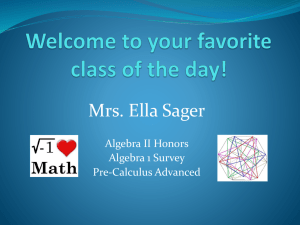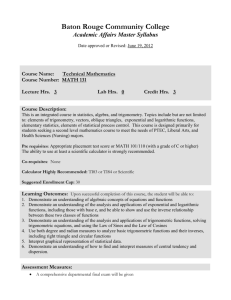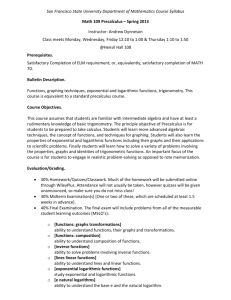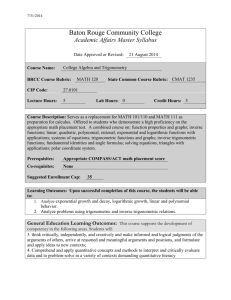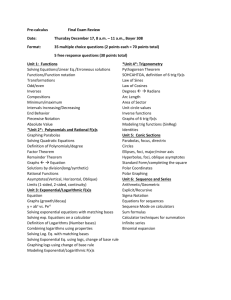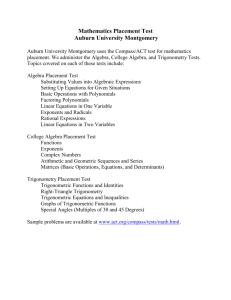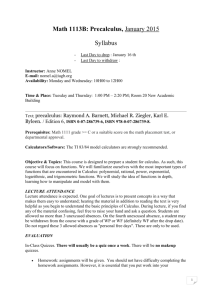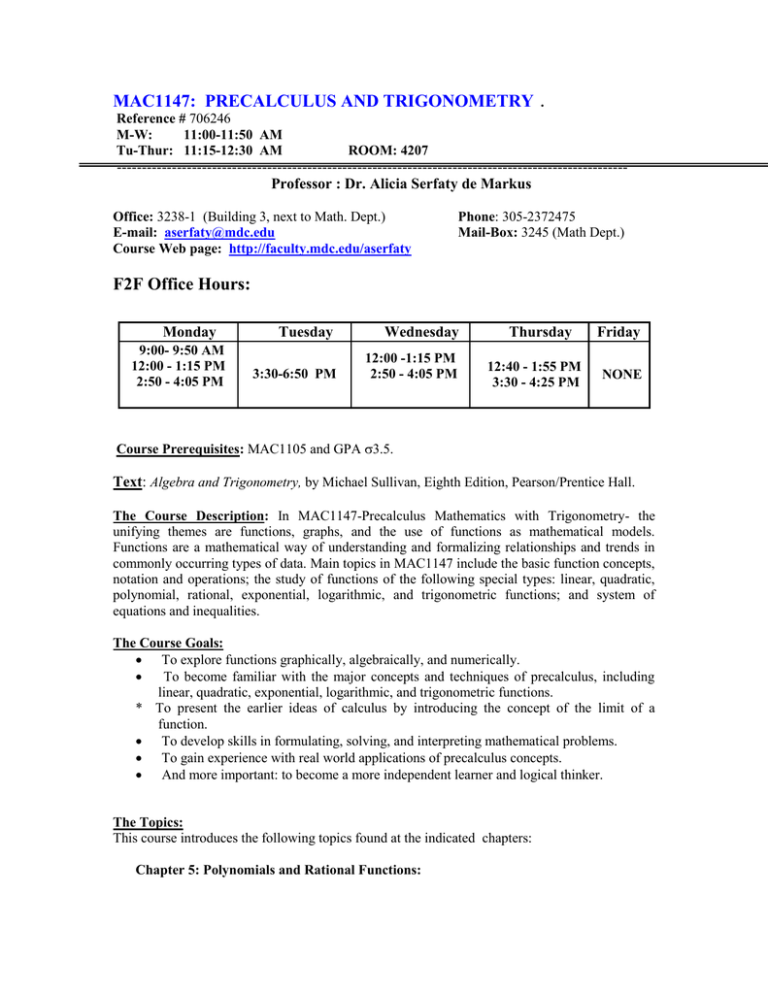
MAC1147: PRECALCULUS AND TRIGONOMETRY
Reference # 706246
M-W:
11:00-11:50 AM
Tu-Thur: 11:15-12:30 AM
.
ROOM: 4207
-----------------------------------------------------------------------------------------------------Professor : Dr. Alicia Serfaty de Markus
Office: 3238-1 (Building 3, next to Math. Dept.)
E-mail: aserfaty@mdc.edu
Course Web page: http://faculty.mdc.edu/aserfaty
Phone: 305-2372475
Mail-Box: 3245 (Math Dept.)
F2F Office Hours:
Monday
9:00- 9:50 AM
12:00 - 1:15 PM
2:50 - 4:05 PM
Tuesday
Wednesday
3:30-6:50 PM
12:00 -1:15 PM
2:50 - 4:05 PM
Thursday
12:40 - 1:55 PM
3:30 - 4:25 PM
Friday
NONE
Course Prerequisites: MAC1105 and GPA 3.5.
Text: Algebra and Trigonometry, by Michael Sullivan, Eighth Edition, Pearson/Prentice Hall.
The Course Description: In MAC1147-Precalculus Mathematics with Trigonometry- the
unifying themes are functions, graphs, and the use of functions as mathematical models.
Functions are a mathematical way of understanding and formalizing relationships and trends in
commonly occurring types of data. Main topics in MAC1147 include the basic function concepts,
notation and operations; the study of functions of the following special types: linear, quadratic,
polynomial, rational, exponential, logarithmic, and trigonometric functions; and system of
equations and inequalities.
The Course Goals:
To explore functions graphically, algebraically, and numerically.
To become familiar with the major concepts and techniques of precalculus, including
linear, quadratic, exponential, logarithmic, and trigonometric functions.
* To present the earlier ideas of calculus by introducing the concept of the limit of a
function.
To develop skills in formulating, solving, and interpreting mathematical problems.
To gain experience with real world applications of precalculus concepts.
And more important: to become a more independent learner and logical thinker.
The Topics:
This course introduces the following topics found at the indicated chapters:
Chapter 5: Polynomials and Rational Functions:
Polynomial functions play an important role in mathematics because virtually all the
functions used in mathematics and the sciences are evaluated using polynomial
approximations. Topics include:
Polynomial functions and graphs
Real Zeros of Polynomials
The Fundamental Theorem of Algebra
Complex Numbers and Rational Functions
Chapter 6: Exponential and Logarithmic Functions:
These are two of the most important functions in mathematics. We use exponential functions
to describe exponential growth in biology and economics, radioactive decay in physics and
chemistry, current/voltage behavior in electrical circuits, heat diffusion, intensity of
earthquakes, compounded interest, declining cell phone prices, spread of an epidemic, our
planet’s human population and other phenomena. The inverse of the exponential function, the
logarithm function, will help to understand and answer questions involving exponential
functions. Topics include:
Exponential and logarithmic functions
Laws of logarithm
Exponential and Logarithmic Equations
Exponential and logarithm Equations and some models.
Chapter 7
Study of the graphical and geometric properties of trigonometric functions. We introduce two
different but equivalent ways of viewing the trigonometric functions. One way is to view
them as a function of real numbers, the other as functions of angles. With trigonometric
functions of real numbers we can deal with dynamic applications to model many types of
cyclic phenomena, such as the depth of the ocean as the tides force the water to rise and fall.
On the other hand, with trigonometric function of angles we can deal with static applications
such as the measurements of distance using triangles. Trigonometry is an indispensable tool
in physics, engineering, computer science, biology and practically all the sciences. Topics
include:
Angle measure
Trigonometry of right triangles
Trigonometry functions of angles
The unit circle
Trigonometric functions of real numbers
Trigonometric graphs.
Chapter 8: Analytic Geometry:
Study of the algebraic aspects of Trigonometry: that is, simplifying and factoring expressions
and solving equations that involve trigonometric functions. In this chapter we define the
inverse trigonometric functions as well. Topics include
Trigonometric identities
Addition and subtraction formulas
Double-Angle, Half-Angle, and Product-Sum Formulas
Inverse Trigonometric Formulas
Trigonometric Equations
Chapter 9 and 10: Applications of Trigonometric Functions and Vectors
As we have already defined the six trigonometric functions, in this chapter we introduce some
theorems that are used often in measuring unknown distances and areas. Also applications on
simple harmonic motion and damped motion are outlined. From Chapter 10 we outline the
concept of a vector as a quantity that has magnitude and direction, such as a force. Topics
include:
Law of Sine.
Law of Cosines.
Areas
Vectors. Dot Product.
Chapter 11: Conic Sections:
Many buildings employ conic sections in their designs, because if its stability and
beauty. The equations of the conics are helpful in manufacturing many objects. Conic
sections are the curves we get when we make a straight cut in a cone. There are many
applications of conic sections in architecture and engineering. In this chapter we will
find equations whose graphs are the conic sections. Topics include
Parabolas
Ellipses
Hyperbolas
Shifted Conics
Chapter 12: System of Equations and Inequalities; Matrices.
Many of the problems to which we can apply the techniques of algebra give rise to set of
equations (that is, a system of equations) with several variables, rather than to just a single
equation in a single variable. In this chapter we develop techniques for finding simultaneous
solutions of such systems. Topics include
System of linear equations in two and more variables
The algebra of matrices
Determinants and Cramer’s rule
System of Inequalities
* Linear Programming
Additional topics may be included/removed at the instructor‘s discretion.
A Scientific Calculator: Use of scientific calculators will be permitted, but not required,
during tests. Graphing calculators can be used in class , but are not permitted in the exams.
Smartphones and calculators with a built-in Computer Algebra System (CAS) such as TI-89,
TI-92, and hp49g; and Personal Digital Assistants (PDAs), laptops and other portable
computers, such as PalmOS and Windows CE devices are not permitted in exams. For the
exams is permitted to use only a basic scientific calculators like the TI-30 and similar.
Attendance: Class lectures, discussions and exercises sessions are considered to be crucial to
succeed in this course. Attendance is mandatory, and will be recorded for administrative purposes
every class session. If you miss more than 3 classes, you may be purged from the course. It is
your responsibility to attend each lecture and keep records of assignments and other information
delivered during class. If you cannot attend class, it is a common courtesy to email me or leave
me a phone message. Because of the number of students in all of the Professor’s classes, it is not
possible to personally inform each absent student of the material that is missed due to an absence,
or the corresponding assignment. For this reason, please have the name and phone number of at
least one other student in the class that you can call and ask for missed lecture notes and
assignments
Classroom decorum: In order to optimize your learning experience, classroom interruption must
be kept to a minimum. Please make every effort to arrive on time and avoid causing an
interruption if you need to leave early. Please turn your cell phone to a silent mode and avoid
using it during class. In an emergency, you may excuse yourself and leave the classroom.
Electronics policy: In order to optimize your learning experience, operation and use of any
device beyond paper and pencil is not allowed in the classroom during class time (except for use
of calculators when indicated). The use of electronics in any form is disruptive and
distractive, and is therefore prohibited during class. Except in emergencies, those using
such devices must leave the classroom for the remainder of the class period.
Academic dishonesty: Any instance of academic dishonesty will result in a grade of F for the
course and can carry an even more severe penalty such as suspension or expulsion. Take pride in
your own achievements, an unearned passing grade is not worth the paper it is written on.
The Tests:
Please note: Specific dates and topics will be announced in class and posted in the
instructor’s web site, and altered at the discretion of the instructor. It is your responsibility
to verify dates and topics.
Grading Policies: Your final grade will be based on:
Three tests (30 % each)
Online Homework (10%)
The Final Exam (Optional)
There are no make up tests: If you miss a test, the Final Exam will replace one score. The Final
Exam is the only make-up exam. If you have not missed any test, the Final Exam might replace
your lowest test score.
Homework: The graded homework will be online. The student have to purchase the access code
(with or without the book). Additionally, more practice exercises (no graded) will be posted in the
Professor’s web site.
The System of Evaluation:
Every test will consist of short answer questions, multiple choice questions and open ended
and/or applications problems, where all work must show sufficiently many steps to describe the
procedure used to solve the problem(s), so partial credit can be earned.
A grade – 90% and above
B grade – between 80% and 89%
C grade – between 70% and 79%
D grade – between 50% and 69%
F grade – below 50%
In very extreme circumstances, you may request a grade of I (incomplete) only if you are passing
the class and have completed the course past the last date to drop the course with a W.
On-Campus support
The Math/Science Study Center, located in room 3326, is available to you as additional support
for your academic needs. Its operating hours are:
Monday – Thursday:
9:00 AM – 9:00 PM
Friday:
9:00 AM – 3:00 PM
Saturday:
9:00 AM – 12:00 Noon
Important Dates:
Last day to change courses with a 100% refund: Friday August 31.
Last day to withdraw with grade of W: Monday November 5.
Last day of classes: Friday December 14.
Finals exams week: December 15-21.
Holidays: Monday September 3, Monday November 12, Thursday November 24 and
Friday November 25.

